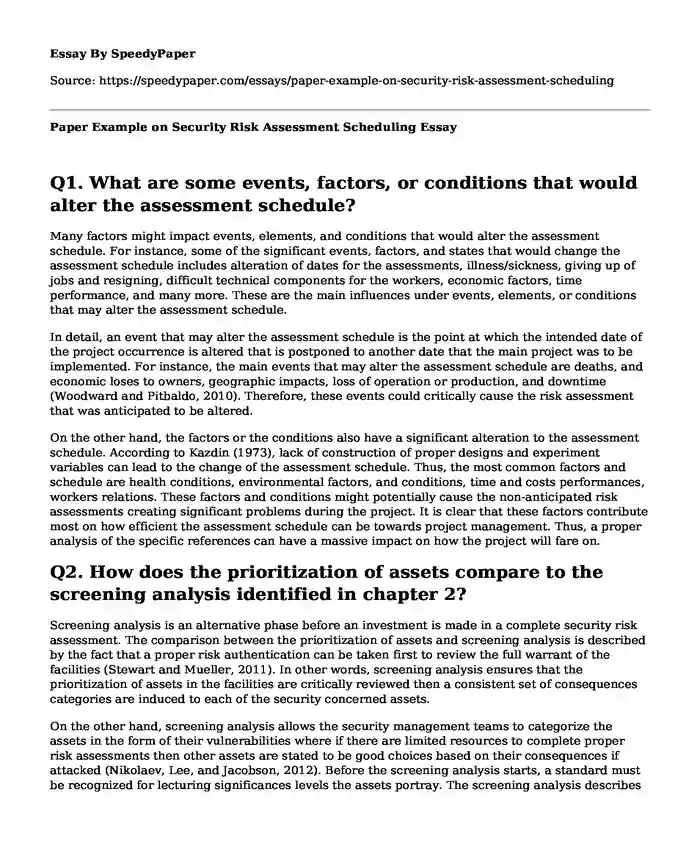
| Type of paper: | Questions & Answers |
| Categories: | Analysis Risk management |
| Pages: | 3 |
| Wordcount: | 676 words |
Q1. What are some events, factors, or conditions that would alter the assessment schedule?
Many factors might impact events, elements, and conditions that would alter the assessment schedule. For instance, some of the significant events, factors, and states that would change the assessment schedule includes alteration of dates for the assessments, illness/sickness, giving up of jobs and resigning, difficult technical components for the workers, economic factors, time performance, and many more. These are the main influences under events, elements, or conditions that may alter the assessment schedule.
In detail, an event that may alter the assessment schedule is the point at which the intended date of the project occurrence is altered that is postponed to another date that the main project was to be implemented. For instance, the main events that may alter the assessment schedule are deaths, and economic loses to owners, geographic impacts, loss of operation or production, and downtime (Woodward and Pitbaldo, 2010). Therefore, these events could critically cause the risk assessment that was anticipated to be altered.
On the other hand, the factors or the conditions also have a significant alteration to the assessment schedule. According to Kazdin (1973), lack of construction of proper designs and experiment variables can lead to the change of the assessment schedule. Thus, the most common factors and schedule are health conditions, environmental factors, and conditions, time and costs performances, workers relations. These factors and conditions might potentially cause the non-anticipated risk assessments creating significant problems during the project. It is clear that these factors contribute most on how efficient the assessment schedule can be towards project management. Thus, a proper analysis of the specific references can have a massive impact on how the project will fare on.
Q2. How does the prioritization of assets compare to the screening analysis identified in chapter 2?
Screening analysis is an alternative phase before an investment is made in a complete security risk assessment. The comparison between the prioritization of assets and screening analysis is described by the fact that a proper risk authentication can be taken first to review the full warrant of the facilities (Stewart and Mueller, 2011). In other words, screening analysis ensures that the prioritization of assets in the facilities are critically reviewed then a consistent set of consequences categories are induced to each of the security concerned assets.
On the other hand, screening analysis allows the security management teams to categorize the assets in the form of their vulnerabilities where if there are limited resources to complete proper risk assessments then other assets are stated to be good choices based on their consequences if attacked (Nikolaev, Lee, and Jacobson, 2012). Before the screening analysis starts, a standard must be recognized for lecturing significances levels the assets portray. The screening analysis describes best how assets can be maximumly protected and catered for in terms of security while the analysis team is developing the standards.
It is clear that chapter two prioritizes the assets through screening analysis as it identifies the critical analysis of the security platforms that involve the assets in order to reduce the number of an anticipated loses. Thus, it is important to note that there can be a massive danger if the screening analysis is used to delete assets from the lists of the risk assessment. Therefore, it is advisable that screening analyses should be used to prioritize the assets and to schedule the security risk assessments for the assets. Therefore, chapter two creates an indigenous comparison between prioritization of assets and screening analysis.
References
Kazdin, A. E. (1973). METHODOLOGICAL AND ASSESSMENT CONSIDERATIONS IN EVALUATING REINFORCEMENT PROGRAMS IN APPLIED SETTINGS 1. Journal of applied behavior analysis, 6(3), 517-531.
Nikolaev, A. G., Lee, A. J., & Jacobson, S. H. (2012). Optimal aviation security screening strategies with dynamic passenger risk updates. IEEE Transactions on intelligent transportation systems, 13(1), 203-212.
Stewart, M. G., & Mueller, J. (2011). Cost-benefit analysis of advanced imaging technology full body scanners for airline passenger security screening. Journal of Homeland Security and Emergency Management, 8(1).
Woodward, J. L., & Pitbaldo, R. (2010). LNG Risk Based Safety: modeling and consequence analysis. John Wiley & Sons.
Cite this page
Paper Example on Security Risk Assessment Scheduling. (2022, Dec 15). Retrieved from https://speedypaper.com/essays/paper-example-on-security-risk-assessment-scheduling
Request Removal
If you are the original author of this essay and no longer wish to have it published on the SpeedyPaper website, please click below to request its removal:
- Free Essay Sample on Islamic Charitable Organizations
- Airline Industry Research Paper Example on the AirAsia X Company
- Learn More about Preschoolers and Nutrition in Our Essay
- Discussion of the Ethics of Human Cloning - Essay Example
- Free Essay on Laboratory Information Management Systems
- Essay Example: Challenges of Organization Theory and Design
- Essay Example: Advocacy Through Legislation
Popular categories




